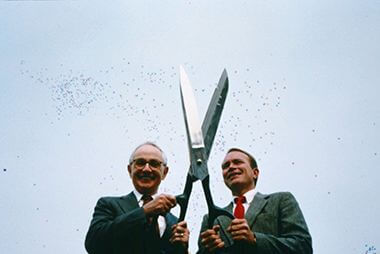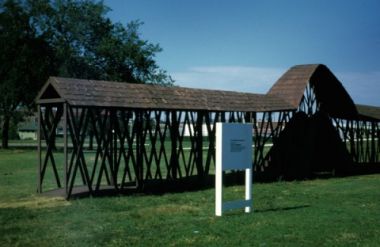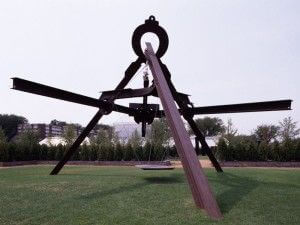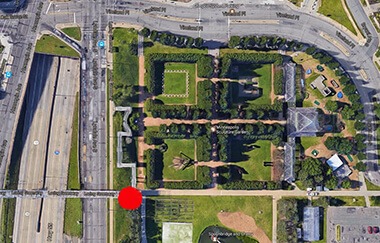Is The Minneapolis Sculpture Garden Free
The largest urban sculpture garden in the country, the Minneapolis Sculpture Garden is a joint project of the Minneapolis Park & Recreation Board (MPRB) and the Walker Art Center. In 2016-17, it was fully reconstructed as a more sustainable, accessible space featuring a number of new artworks.
Take a closer look at the history of the garden and some of the sustainability features incorporated into its 2016-2017 reconstruction below.
Reconstruction from the underground up: soils, sustainability, and a humongous cistern
More than 9 million visitors and 25 years of wear and tear made it clear that sustainability was a key factor in reconstructing the Minneapolis Sculpture Garden. One key to sustainability was dealing with water that, over the years, had caused various types of damage and deterioration, including compacted soils, erosion and uneven pavement. In fact, stormwater drainage was one of the main objectives of the reconstruction project. That may not sound glamorous for a sculpture garden that's considered a "crown jewel" of the Minneapolis park system, but stormwater management, water conservation and related sustainability practices have gone mainstream as the effects of climate change become increasingly evident.
Locally, that's in part due to the work of organizations like the Mississippi Watershed Management Organization (MWMO), which protects and improves water quality and other natural resources in the watershed draining into the Mississippi River. MWMO also invested $1.5 million in reconstructing the garden, helping to showcase sustainable landscaping that "embraces the site's natural hydrology," as MWMO's Nick Busse wrote on the organization's blog. Those sustainability elements include:

Installation of the underground cistern in fall 2016. Courtesy MWMO
Water reuse system
An 80,000-gallon underground cistern is the heart of this system, buried underground at the nexus of the garden, adjacent to theSpoonbridge and Cherry sculpture. It stores stormwater and excess water fromSpoonbridge's fountain for reuse in irrigating the garden and the nearby baseball field in Parade Park, all while keeping more than four million gallons of runoff out of storm sewers each year.
Fresh meadow
The garden's low-lying land and damp soils are characteristic of the "natural hydrology" mentioned above—and make the northern half of the garden a great site for a fresh meadow. That's not just a pretty name, but a technical term for a landscape of deep-rooted native plants that thrive in wet soil, but not standing water. As the 17,656 seedlings grow into the garden's fresh meadow, they will absorb stormwater runoff and filter out pollutants.
Enhanced turf and engineered soils
These elements work together as the landscape's foundation; the former is designed to withstand considerable foot traffic, while the latter provides optimal drainage and a stable foundation for the new pavement and paths.
A Groundbreaking Arrangement

Martin Friedman and David Fisher with a model of the garden (courtesy Walker Art Center)
The Minneapolis Sculpture Garden was a unique idea almost thirty years ago, when Walker director emeritus Martin Friedman reached out to then-MPRB superintendent David Fisher. On the occasion of the garden's 25th anniversary in 2013, Friedman recalled in an interview with the Walker how the idea developed out of the earlier opportunities to install sculptures on the field across the street from the art center (see earlier post below: "The Minneapolis Park Board and Walker Art Center: An Intertwined History"). He also noted that he "always worried about the future of that land," which perhaps led to his idea for a park as "a creative partnership" where the Walker would oversee "all the artistic phenomena," and the city's park agency providing maintenance. Not long after, he reached out to David Fisher, who'd just begin his job overseeing the city's parks, and whom Friedman described as "a very canny bureaucrat … a tough trader and a terrific public servant. Working with him was great fun."

The duo on the garden's opening day (courtesy Walker Art Center)
Fisher returned the compliments, calling Friedman "probably the best-hearted and most intelligent person I've ever worked with." He listened "very carefully" to Friedman's pitch for "a garden that was more a reflection of the Walker. … I understood the parameters of public policy, and quite frankly, I started to understand that Martin also understood the parameters of public policy. He knew that this had to go through a process." In other words, "We worked at it very, very slowly," Fisher recalled, eventually getting to "a situation where we had both the public (my board) and the private (the Walker's board) agreeing to a partnership that would develop a sculpture garden. … It was a groundbreaking arrangement."
Since the Minneapolis Sculpture Garden opened in 1988, the trinity essential to its success—major works of art, an urban setting, and not least, a truly public space open to all—has served as inspiration for other sculpture gardens around the U.S., among them Chicago's Millennium Park; the John and Mary Pappajohn Sculpture Park in Des Moines; Yerba Buena Gardens, adjacent to the Yerba Buena Center for the Arts in San Francisco; the St. Louis Citygarden; and the Seattle Art Museum's Olympic Sculpture Park. Add those to your itinerary for future trips—after attending the Minneapolis Sculpture Garden's reopening on June 10.
The Minneapolis Park Board and Walker Art Center: An Intertwined History

Covered Foot Bridge (Bridge over a Nice Triangle Tree), Siah Armajani, 1970
By 1970, both the Walker Art Center (built as the Walker Art Gallery in 1927) and the Kenwood Garden (built as the Armory Garden in 1913) had been razed. In the garden's case, it was due to the construction of the I-94/Lowry Tunnel highway project (see "Garden Prehistory, In Brief" below). As for the Walker, it was constructing a new building for its growing art collection, one that included galleries better suited to large-scale contemporary work.

Google map of Kenwood Parkway and Loring Park
In the meantime, it had organized9 Artists/9 Spaces, an exhibition of site-specific pieces throughout Minneapolis and St. Paul—including the former garden site. As Walker director emeritus Martin Friedman wrote, "There was a whiff of the future in what transpired on the vanished Armory's site. As his contribution to the exhibition, the young Minneapolis-based sculptor, Siah Armajani, laboriously carpentered an 85-foot long wooden bridge, smack in the middle of the field. Its trestle-like structure was vaguely evocative of rough-timbered bridges throughout the American countryside—but with a remarkable difference. At its center, Armajani's bridge suddenly rose to a gabled peak, to accommodate a lone pine tree planted beneath it-an arresting, provocative, and anti-functional image."

Irene Hixon Whitney Bridge, Siah Armajani, 1988
That "whiff of the future" Friedman noted was the Irene Hixon Whitney Bridge, which Armajani designed in 1985 to connect the planned Minneapolis Sculpture Garden with Loring Park. The Whitney Bridge restores an important parkland connection in crossing over Lyndale Avenue, I-94 and Hennepin Avenue, a formidable 16 lanes of traffic in all. As shown in the yellow highlight on the map, it is an elevated replacement, of sorts, for a long-ago lost segment of Kenwood Parkway, whose eastern end once began at Loring Park and ran west, along the north side of the Armory/Kenwood Garden, before meandering southwest to Lake of the Isles.

Are Years What? (For Marianne Moore), Mark di Suvero, 1967
As an early example of situating large-scale contemporary artworks in the urban public realm, the9 Artists/9 Spaces exhibition was notably problematic. Artist/designer Peggy Weil described in her account of the show that "each piece fell victim to controversy or mishap, with many of artworks succumbing to vandalism of some sort," and Friedman himself noted that "practically everything was destroyed in one way or another by the public."
Nevertheless, the Park Board remained open to loaning land for contemporary art exhibitions. Perhaps its relationship with the Walker's performing arts curator helped: Since 1968, Suzanne Weil had organized hundreds of arts events throughout the city—including concerts in and on the lakes, "where the musicians were on rafts and the audience was on shore, and the reverse where the musicians were on shore and the audience were in canoes," wrote Peggy Weil (relationship unknown).

Arikidea, Mark di Suvero, 1977-1982
So in 1971, in conjunction with the grand opening of the new and much-lauded Walker Art Center, Mark di Suvero'sAre Years What? (For Marianne Moore) was shown on the same site as Armajani's foot bridge the previous year. Like Armajani, di Suvero had a featured piece in the Minneapolis Sculpture Garden when it opened in 1988, andArikidea has been a favorite of visitors ever since. Get reacquainted with both artworks, and dozens more old and new, when the garden reopens on June 3.
Garden prehistory, in brief: 1906 to 1967

A view of the Armory Garden, looking to the southwest.
Even though the Minneapolis Sculpture Garden is relatively young—it turns 30 next year—this parkland's history as a garden dates back more than a century. In fact, the formal quartet of "roofless galleries" that anchors the garden, often likened to formal 18th-century European designs, this link to the early 20th century is more direct.
The land that became the Minneapolis Sculpture Garden was donated to the Park Board in 1906 by Thomas Lowry, whose home was just up the hill, where the Walker Art Gallery and Walker Art Center would later be built. This acreage was just a small slice of the total land donated for parks over the years by Lowry, a real-estate magnate and head of the Minneapolis Street Railway Co. (later the Twin Cities Rapid Transit System).

Red dot shows the approximate point where the historic photo was taken.
In 1913, the land caught the eye of then-parks superintendent Theodore Wirth, who approached the Park Board with a temporary proposal: A formal garden that would coincide with the national convention of the Society of American Florists and Ornamental Horticulturists, to be held that summer at the neighboring Armory. Wirth had a strong horticultural bent: In 1907, he designed the beloved Lyndale Park Rose Garden, which technically is the second-oldest public rose garden in the U.S.—but Wirth also designed the oldest, in Hartford, CT in 1904, when he was superintendent of parks for that city.
The resulting Armory Garden didn't just make a splash with the out-of-town florists; it was an instant hit with the locals, so much so that it endured for more than 50 years. With the demolition of the Armory in 1934 (the white building in the image below), the name changed to Kenwood Garden, which met its own demise in 1967 with the construction of the I-94/Lowry Tunnel highway project. It remained a mostly-empty plot of land for the next two decades.
Next post: Temporary sculpture installations on this parkland set the stage for the country's first public/private sculpture garden.
More Minneapolis Sculpture Garden history
- David C. Smith delved into a deeper history of the Armory Garden on his fantastic blog,Minneapolis Park History. Smith is author ofCity of Parks: The Story of Minneapolis Parks.
- Walker Art Center director emeritus Martin Friedman penned a lively and insightful account of the history of the parkland and its development into the Minneapolis Sculpture Garden in a 1988 essay for the Walker's Design Quarterly. Friedman passed away in 2016, just a day before the groundbreaking for the garden reconstruction.
- In 2013, Twin Cities Public Television (TPT) produced a 26-minute program on the history of the Minneapolis Sculpture Garden in conjunction with its 25th anniversary.
Fun fact #1:The Minneapolis Sculpture Garden is a part of Parade Park, originally known as "The Parade"—a reference to its use for military drills by National Guardsman training at the adjacent Armory.
Fun fact #2:The floral displays at the Armory Garden wowed Minneapolis just months after another, more infamous Armory Show shocked the nation. The 1913 exhibition at New York's 69th Regiment Armory displayed some 1,400 modernist and avant-garde artworks and had Americans exclaiming about the boundaries of art—a role played by the future Walker Art Center on a number of occasions, as a leading institution for contemporary art.
Is The Minneapolis Sculpture Garden Free
Source: https://www.minneapolisparks.org/parks__destinations/parks__lakes/gardens__bird_sanctuaries/minneapolis_sculpture_garden/
Posted by: floressirche.blogspot.com

0 Response to "Is The Minneapolis Sculpture Garden Free"
Post a Comment